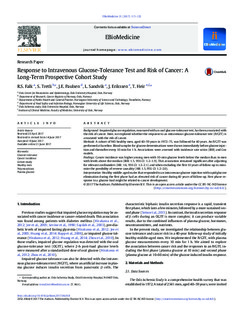| dc.contributor.author | Falk, Ragnhild Sørum | |
| dc.contributor.author | Tretli, Steinar | |
| dc.contributor.author | Paulsen, Jan Erik | |
| dc.contributor.author | Sandvik, Leiv | |
| dc.contributor.author | Erikssen, Jan Emil | |
| dc.contributor.author | Heir, Trond | |
| dc.date.accessioned | 2017-11-27T10:20:56Z | |
| dc.date.available | 2017-11-27T10:20:56Z | |
| dc.date.created | 2017-11-23T14:30:40Z | |
| dc.date.issued | 2017 | |
| dc.identifier.citation | EBioMedicine. 2017, 21 117-122. | nb_NO |
| dc.identifier.issn | 2352-3964 | |
| dc.identifier.uri | http://hdl.handle.net/11250/2468107 | |
| dc.description.abstract | Background
Impaired glucose regulation, measured with an oral glucose-tolerance test, has been associated with the risk of cancer. Here, we explored whether the response to an intravenous glucose-tolerance test (IVGTT) is associated with the risk of cancer.
Methods
A cohort of 945 healthy men, aged 40–59 years in 1972–75, was followed for 40 years. An IVGTT was performed at baseline. Blood samples for glucose determinations were drawn immediately before glucose injection and thereafter every 10 min for 1 h. Associations were assessed with incidence rate ratios (IRR) and Cox models.
Findings
Cancer incidence was higher among men with 10-min glucose levels below the median than in men with levels above the median (IRR: 1.5, 95% CI: 1.2–1.9). This association remained significant after adjusting for relevant confounders (HR: 1.6, 95% CI: 1.3–2.1) and when excluding the first 10 years of follow-up to minimize the possibility of reverse causality (HR: 1.5, 95% CI: 1.2–2.0).
Interpretation
Healthy middle-aged males that responded to an intravenous glucose injection with rapid glucose elimination during the first phase had an elevated risk of cancer during 40 years of follow-up. First phase response to a glucose load might be related to cancer development. | nb_NO |
| dc.language.iso | eng | nb_NO |
| dc.publisher | Elsevier | nb_NO |
| dc.rights | Attribution-NonCommercial-NoDerivatives 4.0 Internasjonal | * |
| dc.rights.uri | http://creativecommons.org/licenses/by-nc-nd/4.0/deed.no | * |
| dc.title | Response to Intravenous Glucose-Tolerance Test and Risk of Cancer: A Long-Term Prospective Cohort Study | nb_NO |
| dc.type | Journal article | nb_NO |
| dc.type | Peer reviewed | nb_NO |
| dc.description.version | publishedVersion | nb_NO |
| dc.source.pagenumber | 117-122 | nb_NO |
| dc.source.volume | 21 | nb_NO |
| dc.source.journal | EBioMedicine | nb_NO |
| dc.identifier.doi | 10.1016/j.ebiom.2017.06.018 | |
| dc.identifier.cristin | 1517751 | |
| dc.description.localcode | © 2017 The Authors. Published by Elsevier B.V. This is an open access article under the CC BY-NC-ND license (http://creativecommons.org/licenses/by-nc-nd/4.0/). | nb_NO |
| cristin.unitcode | 194,65,20,0 | |
| cristin.unitname | Institutt for samfunnsmedisin og sykepleie | |
| cristin.ispublished | true | |
| cristin.fulltext | original | |
| cristin.qualitycode | 1 | |

